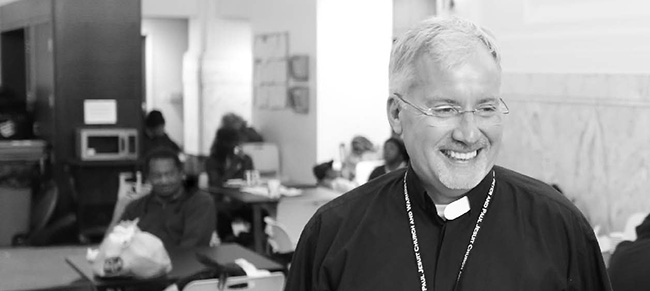
By Fr. Tim McCabe, SJ
My muscles tensed. My Irish temper flared. Someone had vandalized our “Homeless Jesus” statue. Then the unexpected happened.
The statue arrived last year when an anonymous donor paid to install it in front of Ss. Peter & Paul Jesuit Church in downtown Detroit. It was dedicated the week after I began my assignment as the associate pastor and director of the Pope Francis Center, the parish’s homeless ministry.
After Mass, our bishop and more than 200 people stood in front of the church as I offered a blessing of dedication.

|
| The “Homeless Jesus” statue outside Ss. Peter & Paul Jesuit Church in downtown Detroit |
On this cold December morning, I looked at the desecration of this sacred work of art and mumbled, “What were you thinking?” As I stared at the scene before me, I started to see what I had not seen before. The image began to reveal not vandalism but much its opposite. It disclosed the compassion of one of our homeless guests whose reality is frequently altered by mental illness.
Jesus’ body was draped in clothing and blankets, so many that I first wondered if there was another body under them. Tucked in his mouth was a piece of bread. Food particles, an empty water bottle, used napkins, and a coffee stirrer lay on the cement, while a cup of coffee sat above his head on the bench.
 |
| Fr. Tim McCabe, SJ, at Ss. Peter & Paul Jesuit Church's Pope Francis Center |
It is a funny thing, that fine line between insanity and sainthood. Often, I find in my ministry with the homeless that those who struggle most to hold on to reality are capable of profound insights.
The Christological symbols were undeniable: bread broken and shared, placed in Jesus’ mouth; leftover food and drink on the ground beneath him, remnants of a feast — perhaps a wedding banquet; the ground still wet from water poured out. At his head, a cup of coffee waited in expectation of his rising. Unable to put on socks to warm his exposed feet, they were draped over them, like a burial shroud covering his wounds. Neatly folded within the clothing and blankets were coins, the widow’s mite given from her need rather than her surplus.
It was a profound mingling of madness and mysticism, of child’s play and divine command. It was at once reality and insanity, preposterous and prophetic. These were offerings paying homage to our King. “Lord, when did we see you cold and hungry?” And the wounded soul responded.
Please Click here for the Jesuits magazine Spring 2016 Index
A version of this article first appeared in America magazine, December 18, 2015.
Used with permission of America Press, Inc., 2015. All rights reserved. For subscription information, call 1-800-627-9533 or visit www.americamedia.org.